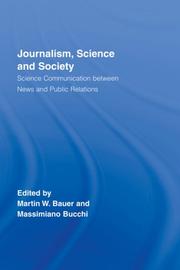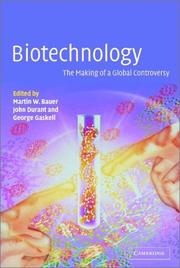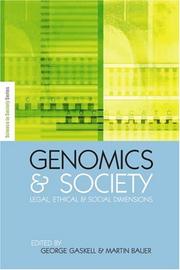| Listing 1 - 10 of 22 | << page >> |
Sort by
|

ISBN: 0521455189 0521599482 0511563701 Year: 1995 Publisher: Cambridge : Cambridge University Press,
Abstract | Keywords | Export | Availability | Bookmark
 Loading...
Loading...Choose an application
- Reference Manager
- EndNote
- RefWorks (Direct export to RefWorks)
This book compares resistance to technology across time, nations, and technologies. Three post-war examples - nuclear power, information technology, and biotechnology - are used in the analysis. The focus is on post-1945 Europe, with comparisons made with the USA, Japan, and Australia. Instead of assuming that resistance contributes to the failure of a technology, the main thesis of the book is that resistance is a constructive force in technological development, giving technology its particular shape in a particular context. Whilst many people still believe in the positive contribution made by science and technology, many have become sceptical. By exploring the idea that modernity creates effects that undermine its own foundations, forms and effects of resistance are explored in various contexts. The book presents a unique interdisciplinary study, including contributions from historians, sociologists, psychologists, and political scientists.
Biotechnology --- Information technology --- Nuclear energy --- Technology assessment --- Biotechnologie --- Technologie de l'information --- Energie nucléaire --- Technologie --- Social aspects --- Congresses --- Aspect social --- Congrès --- Evaluation --- Congresses. --- Energie nucléaire --- Congrès --- Europe --- Technology assessment - Congresses. --- Technology assessment - Europe - Congresses. --- Nuclear energy - Social aspects - Congresses. --- Information technology - Social aspects - Congresses. --- Biotechnology - Social aspects - Congresses. --- Arts and Humanities --- History --- Chemical engineering --- Genetic engineering --- Assessment of technology --- Technological forecasting --- Technological innovations --- Technology and civilization --- Technology and state --- Atomic energy --- Atomic power --- Energy, Atomic --- Energy, Nuclear --- Nuclear power --- Power, Atomic --- Power, Nuclear --- Force and energy --- Nuclear physics --- Power resources --- Nuclear engineering --- Nuclear facilities --- Nuclear power plants

ISBN: 9780511563706 9780521455183 9780521599481 Year: 1995 Publisher: Cambridge Cambridge University Press
Abstract | Keywords | Export | Availability | Bookmark
 Loading...
Loading...Choose an application
- Reference Manager
- EndNote
- RefWorks (Direct export to RefWorks)

ISBN: 190074743X Year: 2001 Publisher: London Science museum
Abstract | Keywords | Export | Availability | Bookmark
 Loading...
Loading...Choose an application
- Reference Manager
- EndNote
- RefWorks (Direct export to RefWorks)
Biotechnology --- 839 Technologie --- #SBIB:316.334.5U32 --- #SBIB:316.334.5U34 --- #SBIB:35H434 --- #SBIB:042.IO --- Sociologie van de landbouw --- Sociologie van stad en platteland: milieuproblematiek --- Beleidssectoren: milieubeleid en ruimtelijke ordening --- 839 Technologie en infrastructuur

ISBN: 9780415375283 0415375282 9780203942314 9781134187249 9781134187287 9781134187294 9780415881340 0203942310 Year: 2007 Volume: 7 Publisher: New York Routledge
Abstract | Keywords | Export | Availability | Bookmark
 Loading...
Loading...Choose an application
- Reference Manager
- EndNote
- RefWorks (Direct export to RefWorks)
Science journalism. --- Science news. --- Presse scientifique --- Sciences --- Vulgarisation --- Journalism, Scientific --- Science news --- #KVHA:Journalistiek --- #KVHA:Media --- #KVHA:Wetenschapsjournalistiek --- 316.77 --- News, Science --- Popularization of science --- Science --- Communication in science --- Journalism --- Technical writing --- Scientific journalism --- 316.77 Communicatiesociologie --- Communicatiesociologie --- Popularization --- Journalism, Scientific. --- Journalistiek --- Wetenschapsberichtgeving --- Nieuws --- Public relations --- Wetenschapscommunicatie --- Reizen --- Ziekte --- Vliegen (werkwoord)

ISBN: 0521773172 052177439X 9780521774390 9780521773171 Year: 2002 Publisher: Cambridge Cambridge University press
Abstract | Keywords | Export | Availability | Bookmark
 Loading...
Loading...Choose an application
- Reference Manager
- EndNote
- RefWorks (Direct export to RefWorks)
Mass media --- Biotechnology --- Social aspects --- Public opinion --- 839 Technologie --- -Mass media --- -Biotechnology --- -#SBIB:316.23H2 --- Chemical engineering --- Genetic engineering --- Mass communication --- Media, Mass --- Media, The --- Communication --- Sociologie van de wetenschappen --- Social aspects. --- Public opinion. --- #SBIB:316.23H2 --- 839 Technologie en infrastructuur --- Biotechnology - Europe - Public opinion --- Mass media - Europe --- Biotechnology - Social aspects

ISBN: 9780761964810 9780761964803 0761964819 Year: 2000 Publisher: London Sage
Abstract | Keywords | Export | Availability | Bookmark
 Loading...
Loading...Choose an application
- Reference Manager
- EndNote
- RefWorks (Direct export to RefWorks)
303.022 --- 303.022 Kwalitatieve methoden bij social research --(sociaal wetenschappelijk onderzoek) --- Kwalitatieve methoden bij social research --(sociaal wetenschappelijk onderzoek) --- Social sciences - Methodology --- Social sciences - Research --- Social sciences - Research - Methodology --- Qualitative research --- Evaluation research (Social action programs) --- Ethnology --- Evaluation research (Social action programs). --- Qualitative research. --- Social sciences --- Methodology. --- Research --- Research. --- #SBIB:303H30 --- Kwalitatieve methoden: algemeen --- Qualitative methods in social research --- sociaal-wetenschappelijk onderzoek
Book
ISBN: 1108236421 1108246125 1108244416 1108416373 Year: 2021 Publisher: Cambridge : Cambridge University Press,
Abstract | Keywords | Export | Availability | Bookmark
 Loading...
Loading...Choose an application
- Reference Manager
- EndNote
- RefWorks (Direct export to RefWorks)
This volume brings together the full range of modalities of social influence - from crowding, leadership, and norm formation to resistance and mass mediation - to set out a challenge-and-response 'cyclone' model. The authors use real-world examples to ground this model and review each modality of social influence in depth. A 'periodic table of social influence' is constructed that characterises and compares exercises of influence in practical terms. The wider implications of social influence are considered, such as how each exercise of a single modality stimulates responses from other modalities and how any everyday process is likely to arise from a mix of influences. The book demonstrates that different modalities of social influence are tactics that defend, question, and develop 'common sense' over time and offers advice to those studying in political and social movements, social change, and management.
Social influence. --- Influence (Psychology) --- Social psychology --- Prestige --- Social pressure

ISBN: 1844071138 9781844071135 Year: 2006 Publisher: London ; Sterling (Va.) : Earthscan,
Abstract | Keywords | Export | Availability | Bookmark
 Loading...
Loading...Choose an application
- Reference Manager
- EndNote
- RefWorks (Direct export to RefWorks)
Bioethical Issues. --- Bioethical Issues. --- Genetic Engineering --- Genetic Engineering --- Genomics --- Genomics --- Genomics --- Genomics --- Genomics. --- Medical genetics --- Medical genetics --- Medical genetics. --- Organisms, Genetically Modified. --- Organisms, Genetically Modified. --- Public policy. --- Public policy. --- ethics. --- ethics. --- Moral and ethical aspects. --- Social aspects. --- ethics. --- ethics. --- Moral and ethical aspects. --- Social aspects.
Book
ISBN: 0367461358 100302713X 1000580547 100302713X Year: 2022 Publisher: Milton Taylor & Francis Group
Abstract | Keywords | Export | Availability | Bookmark
 Loading...
Loading...Choose an application
- Reference Manager
- EndNote
- RefWorks (Direct export to RefWorks)
Book
ISBN: 1134187297 1281706272 9786611706272 0203942310 Year: 2007 Publisher: New York : Routledge,
Abstract | Keywords | Export | Availability | Bookmark
 Loading...
Loading...Choose an application
- Reference Manager
- EndNote
- RefWorks (Direct export to RefWorks)
Analyzing the role of journalists in science communication, this book presents a perspective on how this is going to evolve in the twenty-first century. The book takes three distinct perspectives on this interesting subject. Firstly, science journalists reflect on their 'operating rules' (science news values and news making routines). Secondly, a brief history of science journalism puts things into context, characterising the changing output of science writing in newspapers over time. Finally, the book invites several international journalists or communication scholars to comm
Journalism, Scientific. --- Science news. --- Science journalism.
| Listing 1 - 10 of 22 | << page >> |
Sort by
|

 Search
Search Feedback
Feedback About UniCat
About UniCat  Help
Help News
News